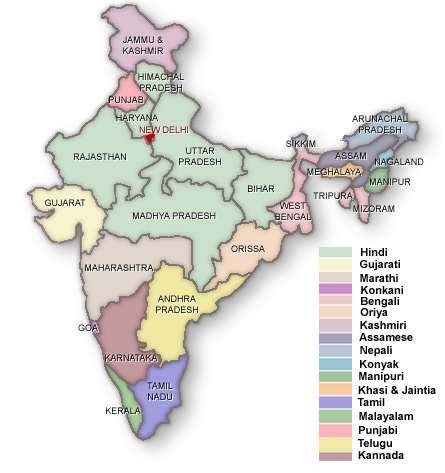Profile of the Hindi Language
Hindi belongs to the Indo-Aryan branch of the Indo-European family of languages. Hindi, along with English, are the official languages of India. Hindi is also the official language of Bihar, Delhi, Haryana, Jharkhand, Madhya Pradesh, Rajasthan, Uttarakhand and Uttar Pradesh. In Chhattisgarh, one of the dialects of Hindi, namely Chhattisgarhi, has recently been made the official language of the state. According to the Census of India, 2001, Hindi is spoken by 422,048,642 speakers which include the speakers of its various dialects and variations of speech grouped under Hindi.
Hindi became the official language of the Union of India in 1950. The Constitution of India provides for the use of Hindi in the Devanagari script as the official language of the Union. According to Article 343, “The official language of the Union shall be Hindi in the Devanagari script. The form of numerals to be used for the official purpose of the Union shall be the international form of Indian numerals.” English was declared an associate language of the Union, and Hindi was supposed to replace English in 1965. The Official Language Act was passed in 1963 providing for the continuation of English as an associate official language in the Union and its use in the parliament for an indefinite period.

After Maithili becoming a national language (included in the VIII Schedule of the Constitution of India along with 21 other languages), Hindi now has 48 officially recognized dialects (Census of India, 2001).
Hindi and Urdu languages have their origins in Khariboli spoken in areas around Delhi. Khariboli was adopted by the Afghans, Persians, and Turks as a common language of interaction with the local population during the period of Islamic invasions and the establishment of Muslim rule in the north of India between the eighth and tenth centuries AD. In time, it developed a variety called Urdu with significant borrowings from Arabic and Persian and that uses the Perso-Arabic script. It was also known as extra “mixed language.”
As Urdu gained patronage in the Muslim courts and developed into a literary language, the variety used by the general population gradually replaced Sanskrit, literary Prakrits, and Apabhramsas as the literary language. This latter variety looked to Sanskrit for linguistic borrowings and Sanskrit, Prakrits, and Apabhramsas for literary conventions. It is this variety that became known as Hindi.
Hindi and Urdu have a common form known as Hindustani, which is a Hindi-Urdu mixed language. Historical and cultural processes and the linguistic affinity that exists in Indian languages led to the emergence of Hindi-Urdu or so-called Hindustani as the lingua franca of major areas of India long before its independence.
Hindi was the language that was adopted by Indian leaders as a symbol of national identity during the struggle for freedom. Hindi has been used as a literary language since the twelfth century. The development of prose, however, began only in the eighteenth century, which marks the emergence of Hindi as a full-fledged literary language.
Grierson (1906) has divided Hindi into two groups: Eastern Hindi and Western Hindi. Between the Eastern and the Western Prakrits there was an intermediate Prakrit called Ardhamagadhi. The modern representative of the corresponding Apabhamsa is Eastern Hindi, and the Chaurasia Apabhramsa of the middle Doab is the parent of Western Hindi. In the Eastern group, Grierson discusses three dialects: Awadhi, Bagheli, and Chhattisgarhi. In the Western group, he explains five dialects: Hindustani, Braj Bhasha, Kanauji, Bundeli, and Bhojpuri. Eastern Hindi is bounded on the north by the language of Nepal, and on the west by various dialects of Western Hindi, of which the principal is Kanauji and Bundeli. On the east, it is bounded by the Bhojpuri dialect of Bihari and by Oriya. On the south, it meets forms of the Marathi language. Western Hindi extends to the foot of the Himalayas on the north, south to the Jamuna valley, and occupies most of Bundelkhand and a part of central provinces on the east side.
The Hindi region is traditionally divided into two: Eastern Hindi and Western Hindi. The main dialects of Eastern Hindi are Awadhi, Bagheli, and Chhattisgarhi. The Western Hindi dialects are Haryanvi, Brajbhasha, Bundeli, Kanuji, and Khariboli. The dialects are spoken in the regions of Bihar (i.e., Maithili, Bhojpuri, and Magahi), Rajasthan (i.e., Marwari, Jaipuri, Malvi, etc.) and some dialects spoken in the northwestern areas of Uttar Pradesh, and Himachal Pradesh were kept away from the earlier classification. Now, all of these dialects are also covered under the term Hindi.
Basic Linguistic Features: Hindi shares major linguistic characteristics with other Indo-Aryan languages. It has ten vowels: a, a:, i, i:, u, u:, e, o, ɛ, and ɔ. The length of vowels is phonemic. All vowels can be nasalized, and nasalization is phonemic. Hindi has 33 consonants (including semi-vowels w and y): p, t, ṭ, k, ph, th, ṭh, kh, b, d, ḍ, g, bh, dh, ḍh, gh, c, ch, j, jh, m, n, ṇ, ŋ, r, ṛ, ṛh, l, s, š, h, w and y.
Nouns are inflected for number, gender, and case. There are two numbers: singular and plural, two grammatical genders: masculine and feminine; and two cases: direct and oblique. Nouns are assigned one of the two genders. The gender of inanimate objects is not predictable from the form or meaning. Pronouns are inflected for number and case. Adjectives are of two types: declinable and indeclinable. The first type (generally, the –a: ending adjectives) is inflected for number, gender, and case, whereas the second type is not. Verbs are inflected for person, number, gender, tense, mood, and aspect. There are three tenses: present, past, and future; three moods: imperative, indicative, and subjunctive; two aspects: imperfective and perfective. Hindi is a verb-final (SOV) language.